Microeconomic Analysis: Elasticities of Demand and Supply, Chapter 5
VerifiedAdded on 2022/12/09
|15
|3186
|258
Report
AI Summary
This document presents a comprehensive overview of elasticities of demand and supply, fundamental concepts in microeconomics. It defines and explains the price elasticity of demand, exploring factors that influence it, and provides methods for its calculation. The report also covers the price elasticity of supply, cross elasticity of demand, and income elasticity of demand. It delves into the concepts of elastic, inelastic, and unit elastic demand, illustrating these with examples and graphical representations. Furthermore, the document discusses the influences on price elasticity, including substitution and income effects, and examines how to compute and apply the price elasticity of demand. The relationship between total revenue and price elasticity is also analyzed, along with practical applications of elasticity, such as in farm prices and addiction. This material is a great resource for students, and Desklib provides additional resources like past papers and solved assignments to aid learning.
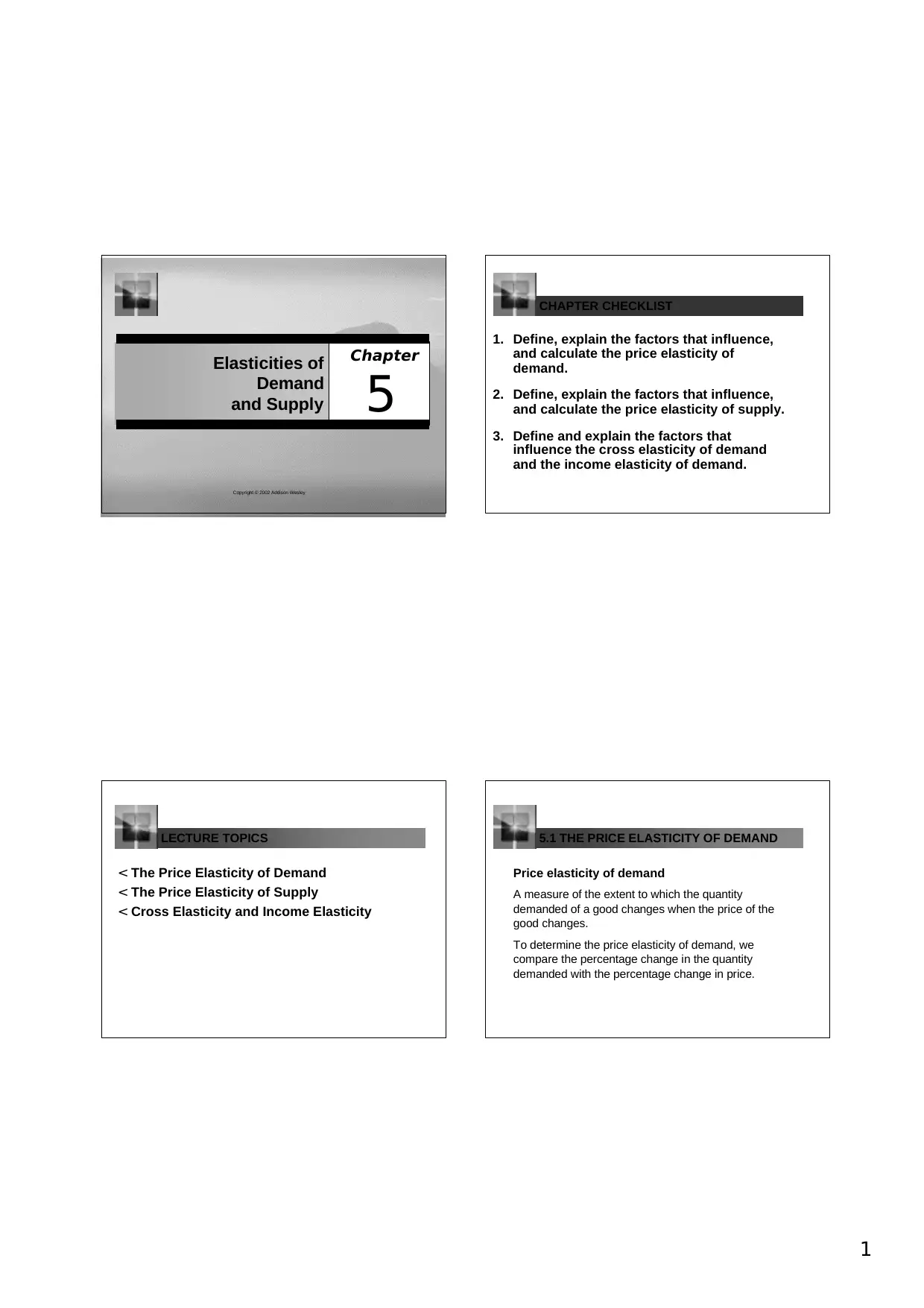
1
Elasticities of
Demand
and Supply
Chapter
5
Copyright © 2002 Addison Wesley
CHAPTER CHECKLIST
1. Define, explain the factors that influence,
and calculate the price elasticity of
demand.
2. Define, explain the factors that influence,
and calculate the price elasticity of supply.
3. Define and explain the factors that
influence the cross elasticity of demand
and the income elasticity of demand.
LECTURE TOPICS
< The Price Elasticity of Demand
< The Price Elasticity of Supply
< Cross Elasticity and Income Elasticity
5.1 THE PRICE ELASTICITY OF DEMAND
Price elasticity of demand
A measure of the extent to which the quantity
demanded of a good changes when the price of the
good changes.
To determine the price elasticity of demand, we
compare the percentage change in the quantity
demanded with the percentage change in price.
Elasticities of
Demand
and Supply
Chapter
5
Copyright © 2002 Addison Wesley
CHAPTER CHECKLIST
1. Define, explain the factors that influence,
and calculate the price elasticity of
demand.
2. Define, explain the factors that influence,
and calculate the price elasticity of supply.
3. Define and explain the factors that
influence the cross elasticity of demand
and the income elasticity of demand.
LECTURE TOPICS
< The Price Elasticity of Demand
< The Price Elasticity of Supply
< Cross Elasticity and Income Elasticity
5.1 THE PRICE ELASTICITY OF DEMAND
Price elasticity of demand
A measure of the extent to which the quantity
demanded of a good changes when the price of the
good changes.
To determine the price elasticity of demand, we
compare the percentage change in the quantity
demanded with the percentage change in price.
Paraphrase This Document
Need a fresh take? Get an instant paraphrase of this document with our AI Paraphraser
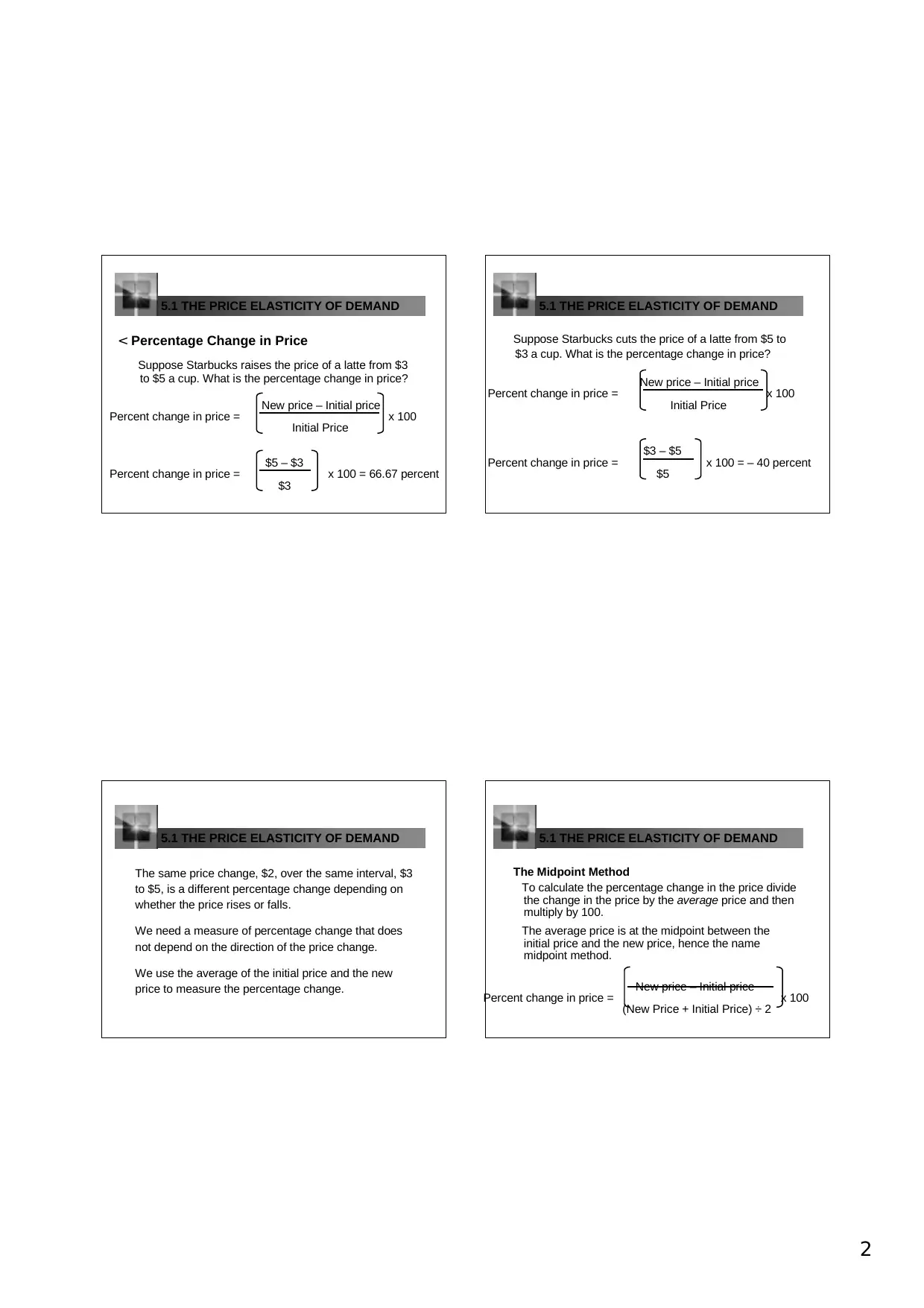
2
5.1 THE PRICE ELASTICITY OF DEMAND
< Percentage Change in Price
Percent change in price = New price – Initial price
Initial Price x 100
Percent change in price = $5 – $3
$3 x 100 = 66.67 percent
Suppose Starbucks raises the price of a latte from $3
to $5 a cup. What is the percentage change in price?
5.1 THE PRICE ELASTICITY OF DEMAND
Suppose Starbucks cuts the price of a latte from $5 to
$3 a cup. What is the percentage change in price?
Percent change in price = New price – Initial price
Initial Price x 100
Percent change in price = $3 – $5
$5 x 100 = – 40 percent
5.1 THE PRICE ELASTICITY OF DEMAND
The same price change, $2, over the same interval, $3
to $5, is a different percentage change depending on
whether the price rises or falls.
We need a measure of percentage change that does
not depend on the direction of the price change.
We use the average of the initial price and the new
price to measure the percentage change.
5.1 THE PRICE ELASTICITY OF DEMAND
The Midpoint Method
x 100Percent change in price = New price – Initial price
(New Price + Initial Price) ÷ 2
To calculate the percentage change in the price divide
the change in the price by the average price and then
multiply by 100.
The average price is at the midpoint between the
initial price and the new price, hence the name
midpoint method.
5.1 THE PRICE ELASTICITY OF DEMAND
< Percentage Change in Price
Percent change in price = New price – Initial price
Initial Price x 100
Percent change in price = $5 – $3
$3 x 100 = 66.67 percent
Suppose Starbucks raises the price of a latte from $3
to $5 a cup. What is the percentage change in price?
5.1 THE PRICE ELASTICITY OF DEMAND
Suppose Starbucks cuts the price of a latte from $5 to
$3 a cup. What is the percentage change in price?
Percent change in price = New price – Initial price
Initial Price x 100
Percent change in price = $3 – $5
$5 x 100 = – 40 percent
5.1 THE PRICE ELASTICITY OF DEMAND
The same price change, $2, over the same interval, $3
to $5, is a different percentage change depending on
whether the price rises or falls.
We need a measure of percentage change that does
not depend on the direction of the price change.
We use the average of the initial price and the new
price to measure the percentage change.
5.1 THE PRICE ELASTICITY OF DEMAND
The Midpoint Method
x 100Percent change in price = New price – Initial price
(New Price + Initial Price) ÷ 2
To calculate the percentage change in the price divide
the change in the price by the average price and then
multiply by 100.
The average price is at the midpoint between the
initial price and the new price, hence the name
midpoint method.
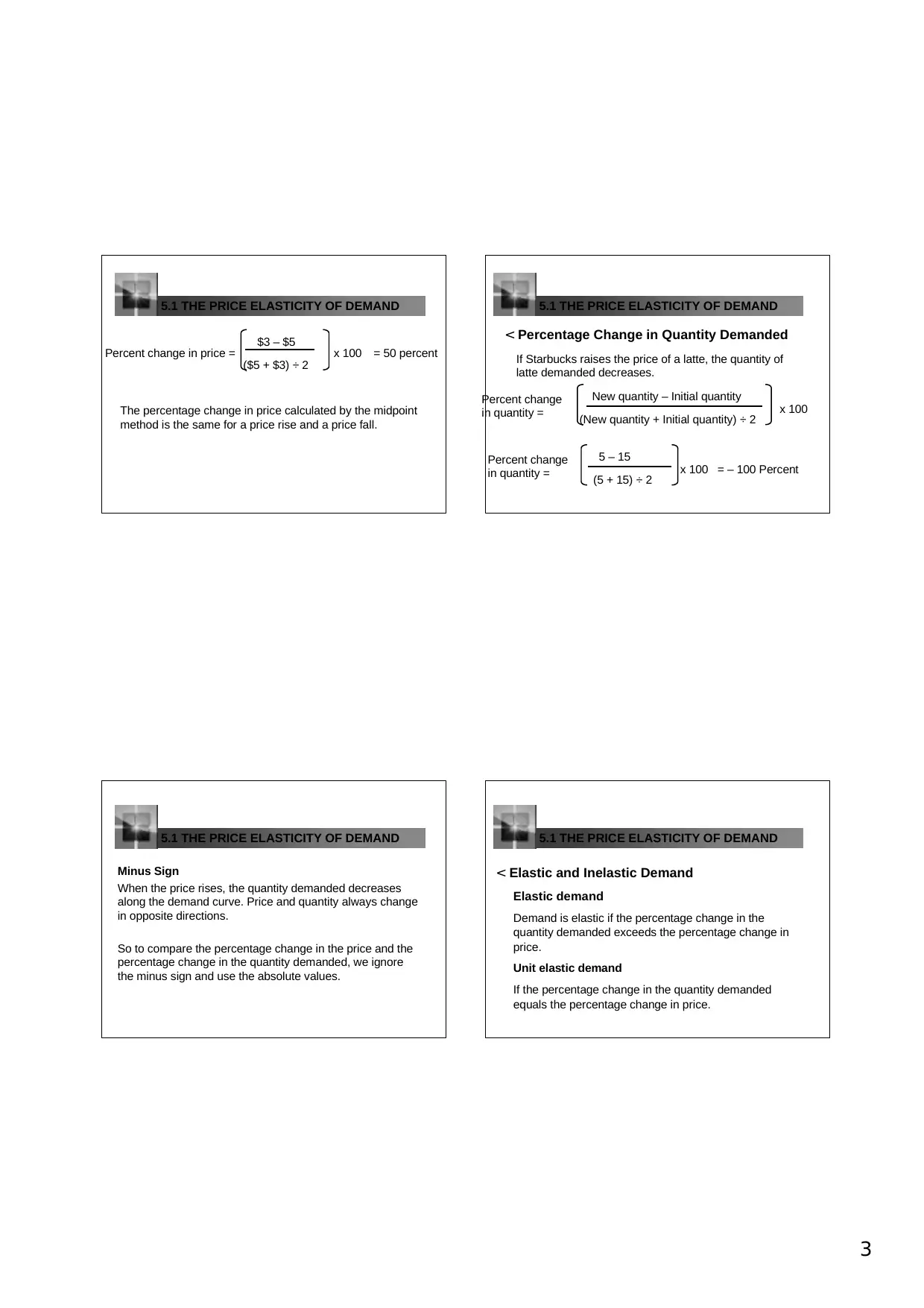
3
5.1 THE PRICE ELASTICITY OF DEMAND
The percentage change in price calculated by the midpoint
method is the same for a price rise and a price fall.
x 100Percent change in price = $3 – $5
($5 + $3) ÷ 2 = 50 percent
5.1 THE PRICE ELASTICITY OF DEMAND
< Percentage Change in Quantity Demanded
x 100
Percent change
in quantity =
New quantity – Initial quantity
(New quantity + Initial quantity) ÷ 2
x 100
Percent change
in quantity =
5 – 15
(5 + 15) ÷ 2 = – 100 Percent
If Starbucks raises the price of a latte, the quantity of
latte demanded decreases.
5.1 THE PRICE ELASTICITY OF DEMAND
Minus Sign
When the price rises, the quantity demanded decreases
along the demand curve. Price and quantity always change
in opposite directions.
So to compare the percentage change in the price and the
percentage change in the quantity demanded, we ignore
the minus sign and use the absolute values.
5.1 THE PRICE ELASTICITY OF DEMAND
< Elastic and Inelastic Demand
Elastic demand
Demand is elastic if the percentage change in the
quantity demanded exceeds the percentage change in
price.
Unit elastic demand
If the percentage change in the quantity demanded
equals the percentage change in price.
5.1 THE PRICE ELASTICITY OF DEMAND
The percentage change in price calculated by the midpoint
method is the same for a price rise and a price fall.
x 100Percent change in price = $3 – $5
($5 + $3) ÷ 2 = 50 percent
5.1 THE PRICE ELASTICITY OF DEMAND
< Percentage Change in Quantity Demanded
x 100
Percent change
in quantity =
New quantity – Initial quantity
(New quantity + Initial quantity) ÷ 2
x 100
Percent change
in quantity =
5 – 15
(5 + 15) ÷ 2 = – 100 Percent
If Starbucks raises the price of a latte, the quantity of
latte demanded decreases.
5.1 THE PRICE ELASTICITY OF DEMAND
Minus Sign
When the price rises, the quantity demanded decreases
along the demand curve. Price and quantity always change
in opposite directions.
So to compare the percentage change in the price and the
percentage change in the quantity demanded, we ignore
the minus sign and use the absolute values.
5.1 THE PRICE ELASTICITY OF DEMAND
< Elastic and Inelastic Demand
Elastic demand
Demand is elastic if the percentage change in the
quantity demanded exceeds the percentage change in
price.
Unit elastic demand
If the percentage change in the quantity demanded
equals the percentage change in price.
⊘ This is a preview!⊘
Do you want full access?
Subscribe today to unlock all pages.

Trusted by 1+ million students worldwide
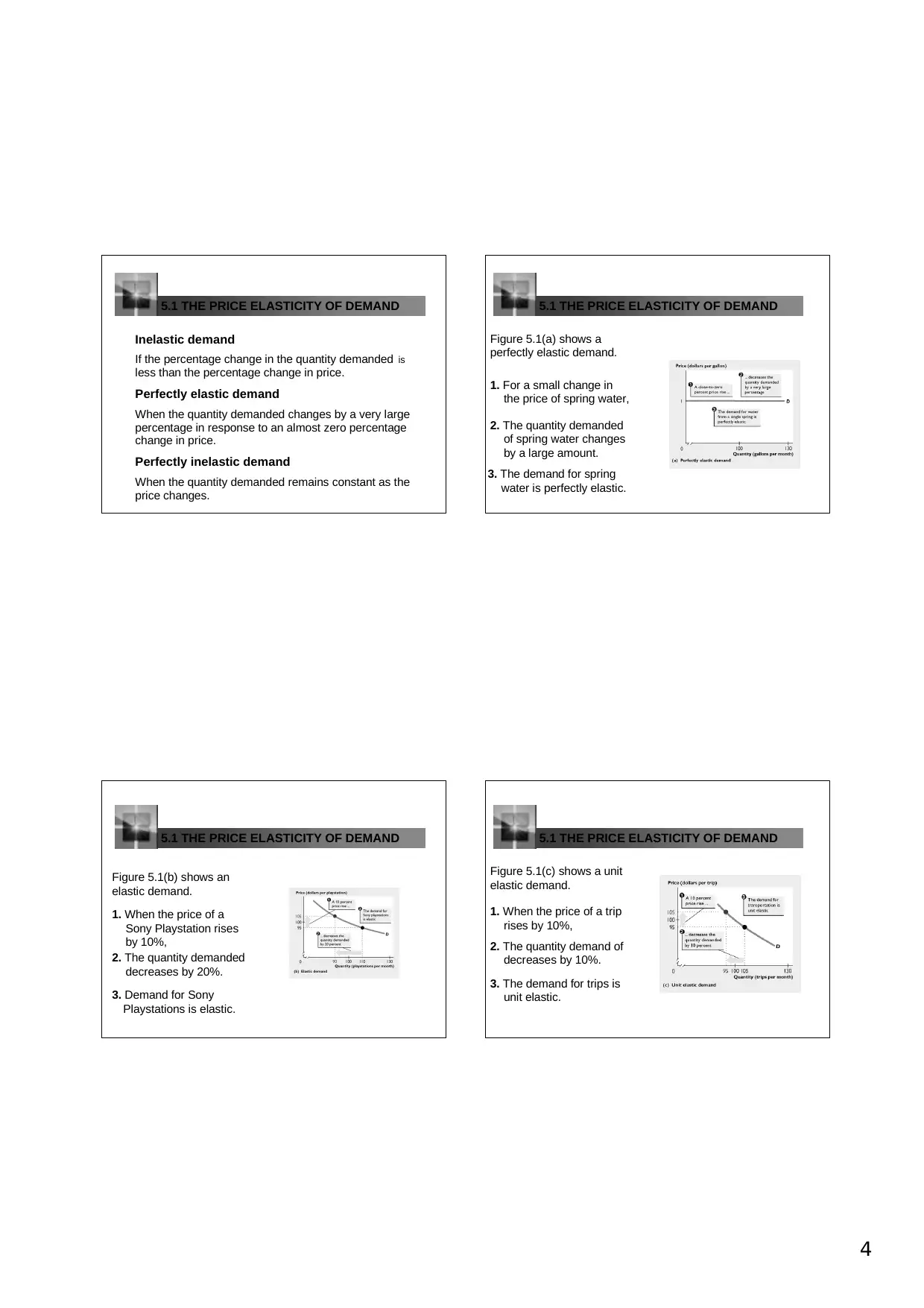
4
5.1 THE PRICE ELASTICITY OF DEMAND
Inelastic demand
If the percentage change in the quantity demanded is
less than the percentage change in price.
Perfectly elastic demand
When the quantity demanded changes by a very large
percentage in response to an almost zero percentage
change in price.
Perfectly inelastic demand
When the quantity demanded remains constant as the
price changes.
5.1 THE PRICE ELASTICITY OF DEMAND
Figure 5.1(a) shows a
perfectly elastic demand.
1. For a small change in
the price of spring water,
2. The quantity demanded
of spring water changes
by a large amount.
3. The demand for spring
water is perfectly elastic.
5.1 THE PRICE ELASTICITY OF DEMAND
Figure 5.1(b) shows an
elastic demand.
1. When the price of a
Sony Playstation rises
by 10%,
2. The quantity demanded
decreases by 20%.
3. Demand for Sony
Playstations is elastic.
5.1 THE PRICE ELASTICITY OF DEMAND
Figure 5.1(c) shows a unit
elastic demand.
1. When the price of a trip
rises by 10%,
2. The quantity demand of
decreases by 10%.
3. The demand for trips is
unit elastic.
5.1 THE PRICE ELASTICITY OF DEMAND
Inelastic demand
If the percentage change in the quantity demanded is
less than the percentage change in price.
Perfectly elastic demand
When the quantity demanded changes by a very large
percentage in response to an almost zero percentage
change in price.
Perfectly inelastic demand
When the quantity demanded remains constant as the
price changes.
5.1 THE PRICE ELASTICITY OF DEMAND
Figure 5.1(a) shows a
perfectly elastic demand.
1. For a small change in
the price of spring water,
2. The quantity demanded
of spring water changes
by a large amount.
3. The demand for spring
water is perfectly elastic.
5.1 THE PRICE ELASTICITY OF DEMAND
Figure 5.1(b) shows an
elastic demand.
1. When the price of a
Sony Playstation rises
by 10%,
2. The quantity demanded
decreases by 20%.
3. Demand for Sony
Playstations is elastic.
5.1 THE PRICE ELASTICITY OF DEMAND
Figure 5.1(c) shows a unit
elastic demand.
1. When the price of a trip
rises by 10%,
2. The quantity demand of
decreases by 10%.
3. The demand for trips is
unit elastic.
Paraphrase This Document
Need a fresh take? Get an instant paraphrase of this document with our AI Paraphraser
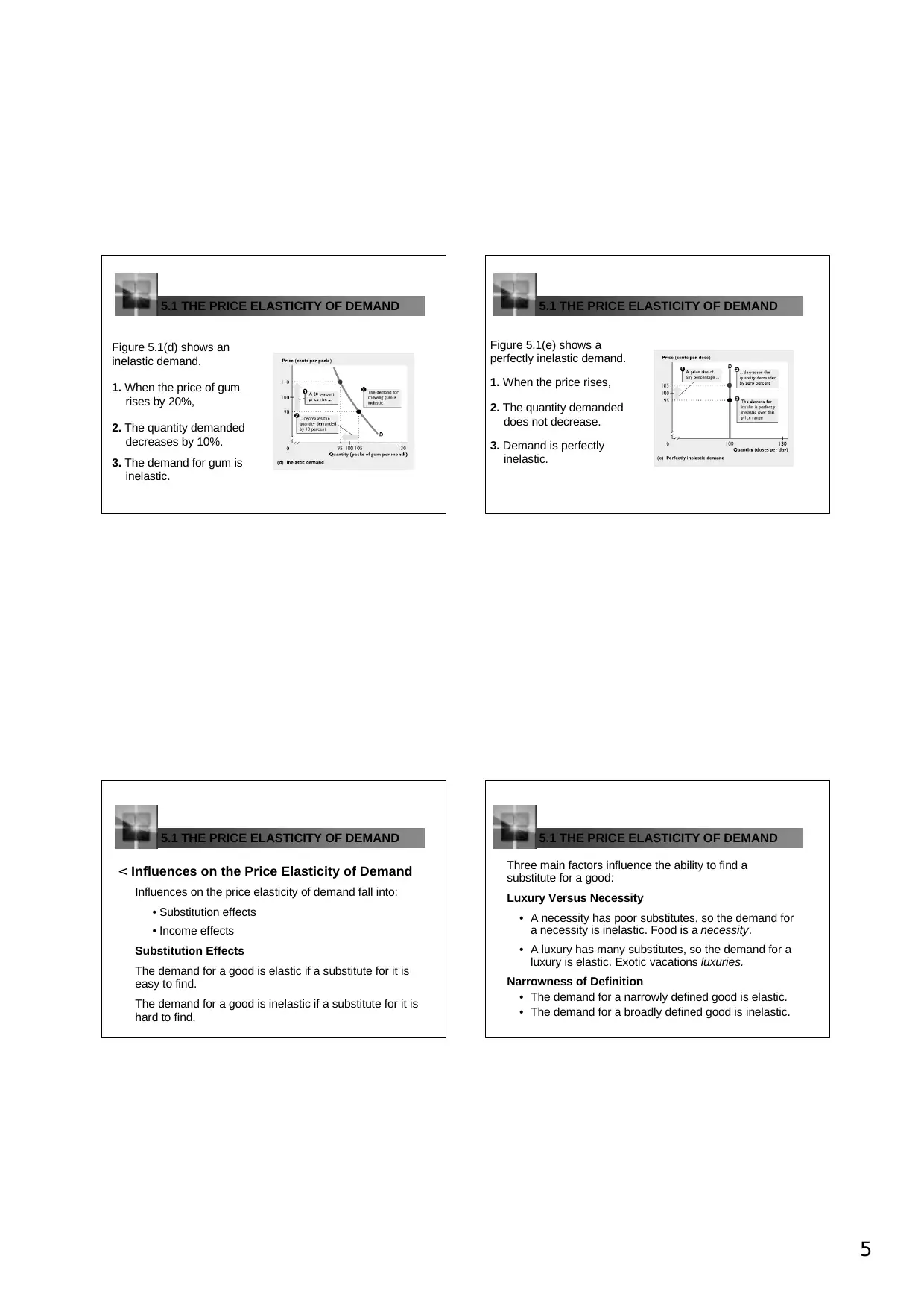
5
5.1 THE PRICE ELASTICITY OF DEMAND
Figure 5.1(d) shows an
inelastic demand.
1. When the price of gum
rises by 20%,
2. The quantity demanded
decreases by 10%.
3. The demand for gum is
inelastic.
5.1 THE PRICE ELASTICITY OF DEMAND
Figure 5.1(e) shows a
perfectly inelastic demand.
1. When the price rises,
2. The quantity demanded
does not decrease.
3. Demand is perfectly
inelastic.
5.1 THE PRICE ELASTICITY OF DEMAND
< Influences on the Price Elasticity of Demand
Influences on the price elasticity of demand fall into:
• Substitution effects
• Income effects
Substitution Effects
The demand for a good is elastic if a substitute for it is
easy to find.
The demand for a good is inelastic if a substitute for it is
hard to find.
5.1 THE PRICE ELASTICITY OF DEMAND
Three main factors influence the ability to find a
substitute for a good:
Luxury Versus Necessity
• A necessity has poor substitutes, so the demand for
a necessity is inelastic. Food is a necessity.
• A luxury has many substitutes, so the demand for a
luxury is elastic. Exotic vacations luxuries.
Narrowness of Definition
• The demand for a narrowly defined good is elastic.
• The demand for a broadly defined good is inelastic.
5.1 THE PRICE ELASTICITY OF DEMAND
Figure 5.1(d) shows an
inelastic demand.
1. When the price of gum
rises by 20%,
2. The quantity demanded
decreases by 10%.
3. The demand for gum is
inelastic.
5.1 THE PRICE ELASTICITY OF DEMAND
Figure 5.1(e) shows a
perfectly inelastic demand.
1. When the price rises,
2. The quantity demanded
does not decrease.
3. Demand is perfectly
inelastic.
5.1 THE PRICE ELASTICITY OF DEMAND
< Influences on the Price Elasticity of Demand
Influences on the price elasticity of demand fall into:
• Substitution effects
• Income effects
Substitution Effects
The demand for a good is elastic if a substitute for it is
easy to find.
The demand for a good is inelastic if a substitute for it is
hard to find.
5.1 THE PRICE ELASTICITY OF DEMAND
Three main factors influence the ability to find a
substitute for a good:
Luxury Versus Necessity
• A necessity has poor substitutes, so the demand for
a necessity is inelastic. Food is a necessity.
• A luxury has many substitutes, so the demand for a
luxury is elastic. Exotic vacations luxuries.
Narrowness of Definition
• The demand for a narrowly defined good is elastic.
• The demand for a broadly defined good is inelastic.
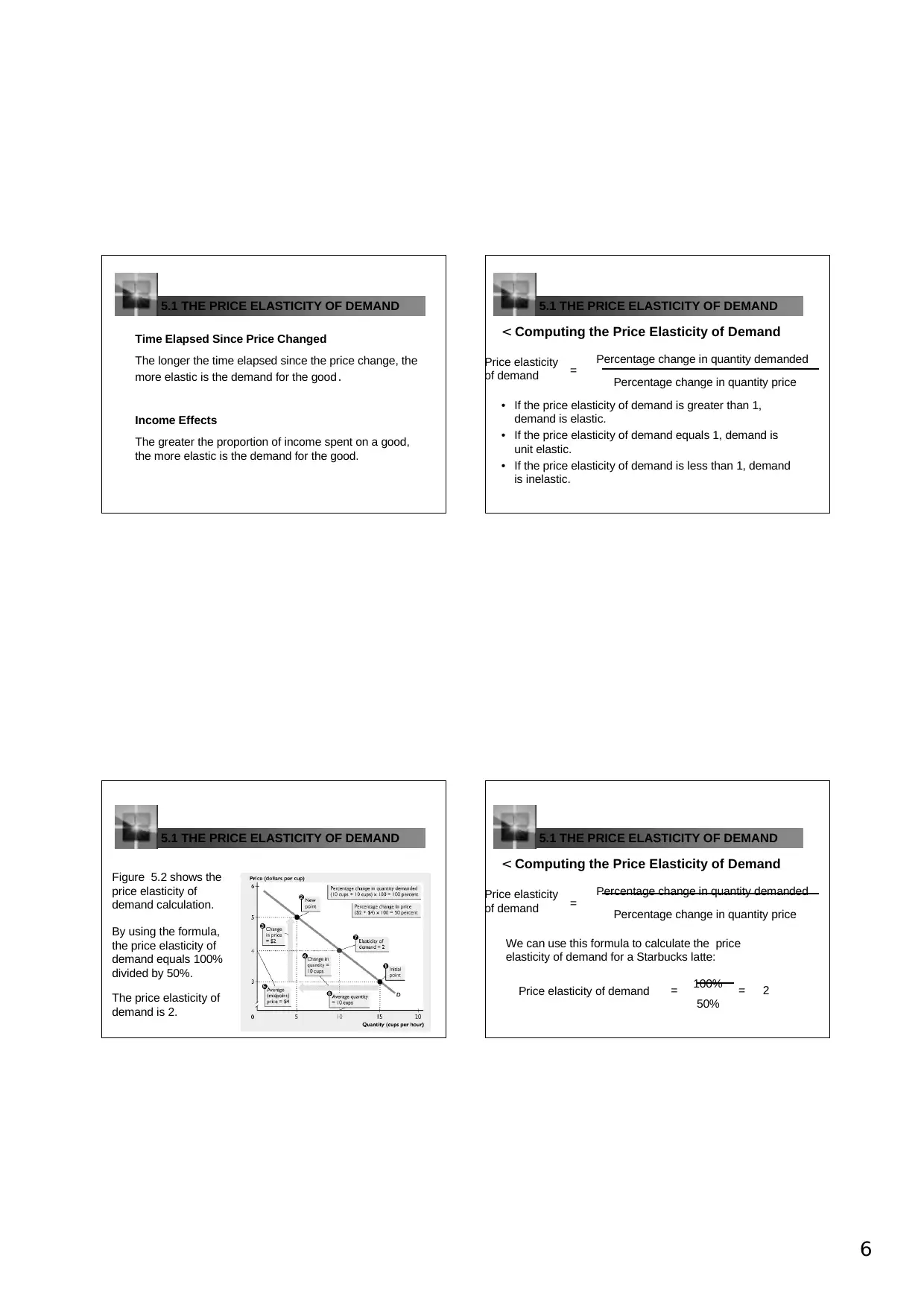
6
5.1 THE PRICE ELASTICITY OF DEMAND
Time Elapsed Since Price Changed
The longer the time elapsed since the price change, the
more elastic is the demand for the good.
Income Effects
The greater the proportion of income spent on a good,
the more elastic is the demand for the good.
5.1 THE PRICE ELASTICITY OF DEMAND
< Computing the Price Elasticity of Demand
• If the price elasticity of demand is greater than 1,
demand is elastic.
• If the price elasticity of demand equals 1, demand is
unit elastic.
• If the price elasticity of demand is less than 1, demand
is inelastic.
Price elasticity
of demand
Percentage change in quantity demanded
Percentage change in quantity price
=
5.1 THE PRICE ELASTICITY OF DEMAND
Figure 5.2 shows the
price elasticity of
demand calculation.
The price elasticity of
demand is 2.
By using the formula,
the price elasticity of
demand equals 100%
divided by 50%.
5.1 THE PRICE ELASTICITY OF DEMAND
< Computing the Price Elasticity of Demand
We can use this formula to calculate the price
elasticity of demand for a Starbucks latte:
Price elasticity
of demand
Percentage change in quantity demanded
Percentage change in quantity price
=
Price elasticity of demand 100%
50%
= 2=
5.1 THE PRICE ELASTICITY OF DEMAND
Time Elapsed Since Price Changed
The longer the time elapsed since the price change, the
more elastic is the demand for the good.
Income Effects
The greater the proportion of income spent on a good,
the more elastic is the demand for the good.
5.1 THE PRICE ELASTICITY OF DEMAND
< Computing the Price Elasticity of Demand
• If the price elasticity of demand is greater than 1,
demand is elastic.
• If the price elasticity of demand equals 1, demand is
unit elastic.
• If the price elasticity of demand is less than 1, demand
is inelastic.
Price elasticity
of demand
Percentage change in quantity demanded
Percentage change in quantity price
=
5.1 THE PRICE ELASTICITY OF DEMAND
Figure 5.2 shows the
price elasticity of
demand calculation.
The price elasticity of
demand is 2.
By using the formula,
the price elasticity of
demand equals 100%
divided by 50%.
5.1 THE PRICE ELASTICITY OF DEMAND
< Computing the Price Elasticity of Demand
We can use this formula to calculate the price
elasticity of demand for a Starbucks latte:
Price elasticity
of demand
Percentage change in quantity demanded
Percentage change in quantity price
=
Price elasticity of demand 100%
50%
= 2=
⊘ This is a preview!⊘
Do you want full access?
Subscribe today to unlock all pages.

Trusted by 1+ million students worldwide
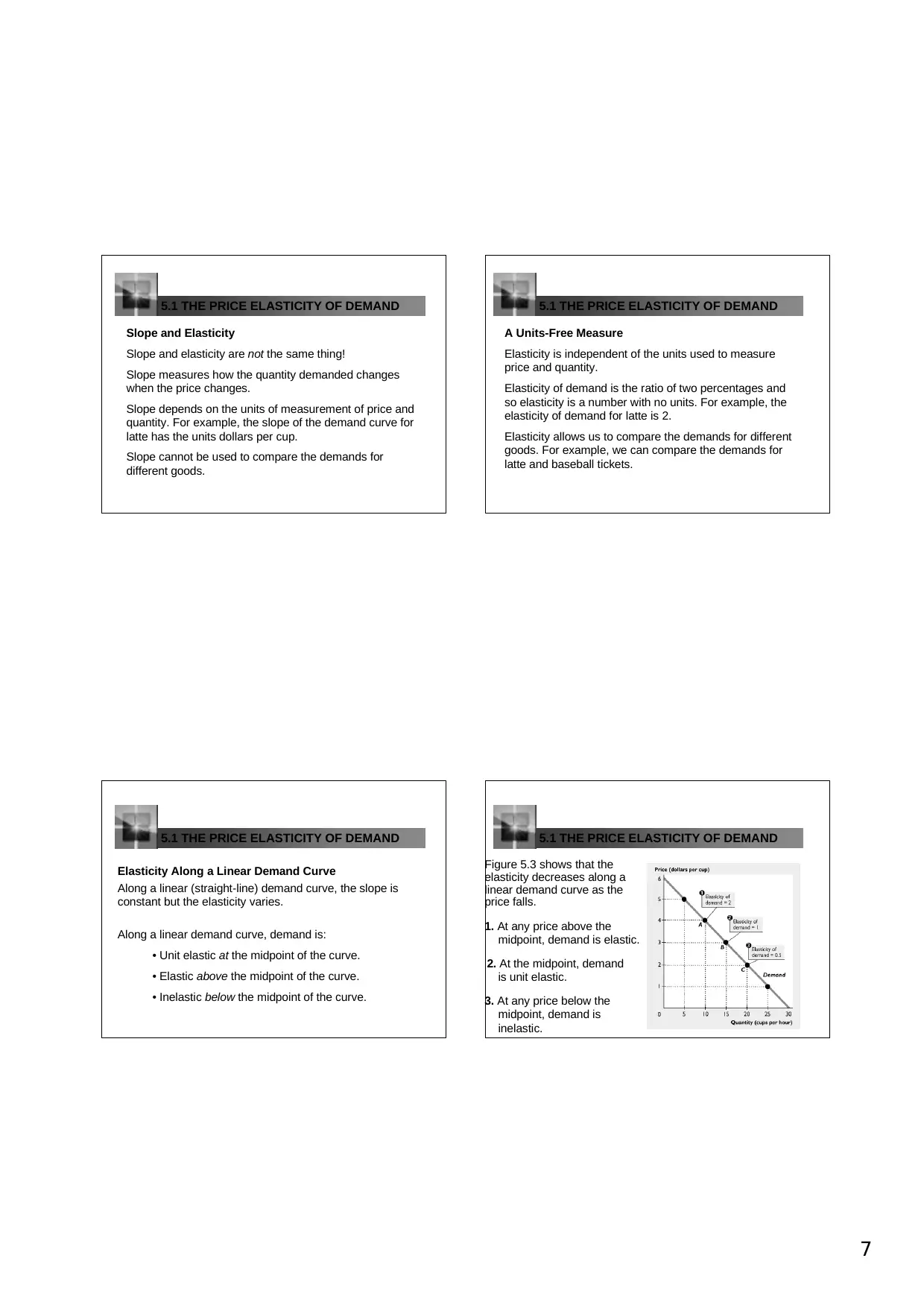
7
5.1 THE PRICE ELASTICITY OF DEMAND
Slope and Elasticity
Slope and elasticity are not the same thing!
Slope measures how the quantity demanded changes
when the price changes.
Slope depends on the units of measurement of price and
quantity. For example, the slope of the demand curve for
latte has the units dollars per cup.
Slope cannot be used to compare the demands for
different goods.
5.1 THE PRICE ELASTICITY OF DEMAND
A Units-Free Measure
Elasticity is independent of the units used to measure
price and quantity.
Elasticity of demand is the ratio of two percentages and
so elasticity is a number with no units. For example, the
elasticity of demand for latte is 2.
Elasticity allows us to compare the demands for different
goods. For example, we can compare the demands for
latte and baseball tickets.
5.1 THE PRICE ELASTICITY OF DEMAND
Elasticity Along a Linear Demand Curve
Along a linear (straight-line) demand curve, the slope is
constant but the elasticity varies.
Along a linear demand curve, demand is:
• Unit elastic at the midpoint of the curve.
• Elastic above the midpoint of the curve.
• Inelastic below the midpoint of the curve.
5.1 THE PRICE ELASTICITY OF DEMAND
Figure 5.3 shows that the
elasticity decreases along a
linear demand curve as the
price falls.
1. At any price above the
midpoint, demand is elastic.
3. At any price below the
midpoint, demand is
inelastic.
2. At the midpoint, demand
is unit elastic.
5.1 THE PRICE ELASTICITY OF DEMAND
Slope and Elasticity
Slope and elasticity are not the same thing!
Slope measures how the quantity demanded changes
when the price changes.
Slope depends on the units of measurement of price and
quantity. For example, the slope of the demand curve for
latte has the units dollars per cup.
Slope cannot be used to compare the demands for
different goods.
5.1 THE PRICE ELASTICITY OF DEMAND
A Units-Free Measure
Elasticity is independent of the units used to measure
price and quantity.
Elasticity of demand is the ratio of two percentages and
so elasticity is a number with no units. For example, the
elasticity of demand for latte is 2.
Elasticity allows us to compare the demands for different
goods. For example, we can compare the demands for
latte and baseball tickets.
5.1 THE PRICE ELASTICITY OF DEMAND
Elasticity Along a Linear Demand Curve
Along a linear (straight-line) demand curve, the slope is
constant but the elasticity varies.
Along a linear demand curve, demand is:
• Unit elastic at the midpoint of the curve.
• Elastic above the midpoint of the curve.
• Inelastic below the midpoint of the curve.
5.1 THE PRICE ELASTICITY OF DEMAND
Figure 5.3 shows that the
elasticity decreases along a
linear demand curve as the
price falls.
1. At any price above the
midpoint, demand is elastic.
3. At any price below the
midpoint, demand is
inelastic.
2. At the midpoint, demand
is unit elastic.
Paraphrase This Document
Need a fresh take? Get an instant paraphrase of this document with our AI Paraphraser
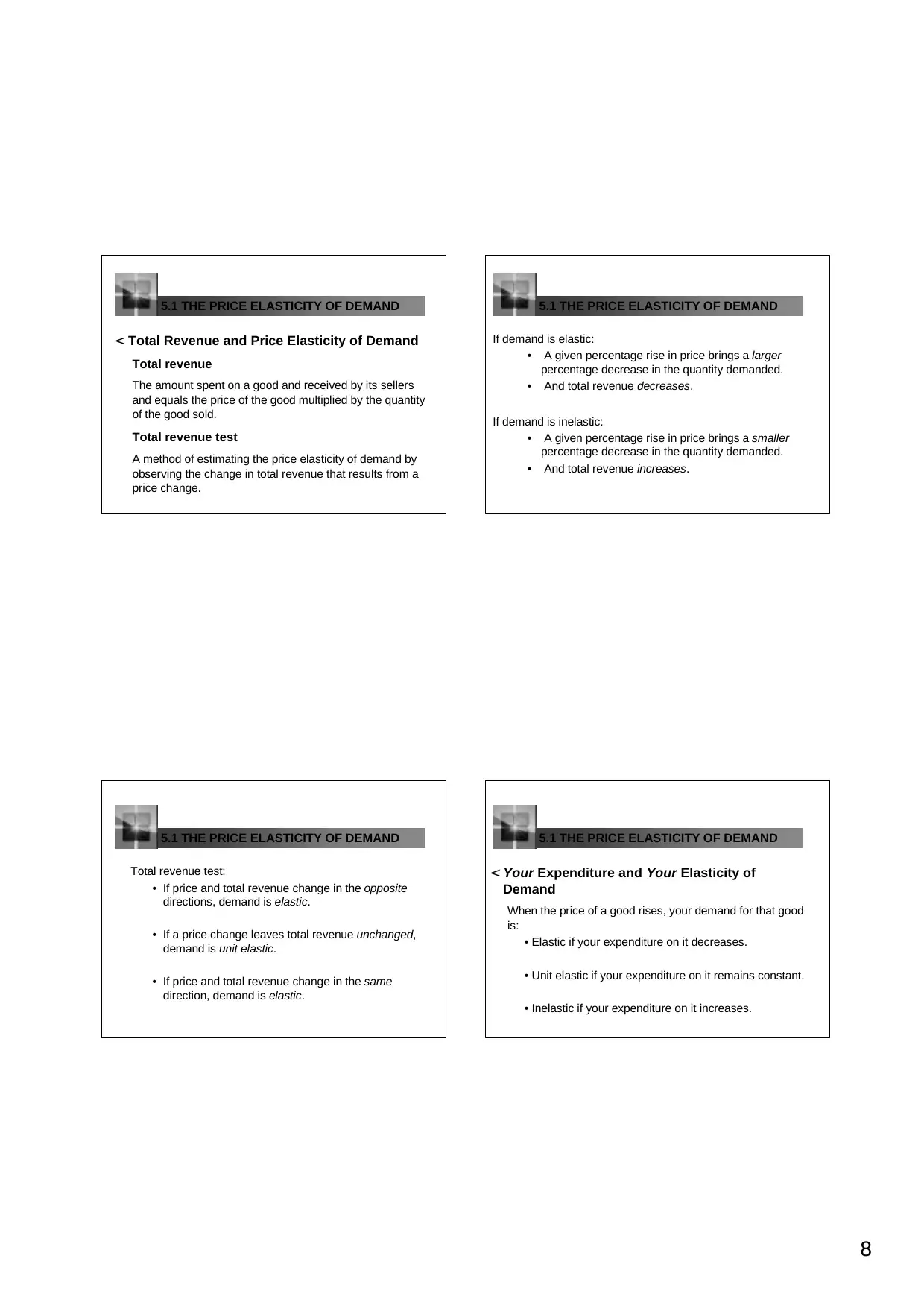
8
5.1 THE PRICE ELASTICITY OF DEMAND
< Total Revenue and Price Elasticity of Demand
Total revenue
The amount spent on a good and received by its sellers
and equals the price of the good multiplied by the quantity
of the good sold.
Total revenue test
A method of estimating the price elasticity of demand by
observing the change in total revenue that results from a
price change.
5.1 THE PRICE ELASTICITY OF DEMAND
If demand is elastic:
• A given percentage rise in price brings a larger
percentage decrease in the quantity demanded.
• And total revenue decreases.
If demand is inelastic:
• A given percentage rise in price brings a smaller
percentage decrease in the quantity demanded.
• And total revenue increases.
5.1 THE PRICE ELASTICITY OF DEMAND
Total revenue test:
• If price and total revenue change in the opposite
directions, demand is elastic.
• If a price change leaves total revenue unchanged,
demand is unit elastic.
• If price and total revenue change in the same
direction, demand is elastic.
5.1 THE PRICE ELASTICITY OF DEMAND
< Your Expenditure and Your Elasticity of
Demand
When the price of a good rises, your demand for that good
is:
• Elastic if your expenditure on it decreases.
• Unit elastic if your expenditure on it remains constant.
• Inelastic if your expenditure on it increases.
5.1 THE PRICE ELASTICITY OF DEMAND
< Total Revenue and Price Elasticity of Demand
Total revenue
The amount spent on a good and received by its sellers
and equals the price of the good multiplied by the quantity
of the good sold.
Total revenue test
A method of estimating the price elasticity of demand by
observing the change in total revenue that results from a
price change.
5.1 THE PRICE ELASTICITY OF DEMAND
If demand is elastic:
• A given percentage rise in price brings a larger
percentage decrease in the quantity demanded.
• And total revenue decreases.
If demand is inelastic:
• A given percentage rise in price brings a smaller
percentage decrease in the quantity demanded.
• And total revenue increases.
5.1 THE PRICE ELASTICITY OF DEMAND
Total revenue test:
• If price and total revenue change in the opposite
directions, demand is elastic.
• If a price change leaves total revenue unchanged,
demand is unit elastic.
• If price and total revenue change in the same
direction, demand is elastic.
5.1 THE PRICE ELASTICITY OF DEMAND
< Your Expenditure and Your Elasticity of
Demand
When the price of a good rises, your demand for that good
is:
• Elastic if your expenditure on it decreases.
• Unit elastic if your expenditure on it remains constant.
• Inelastic if your expenditure on it increases.
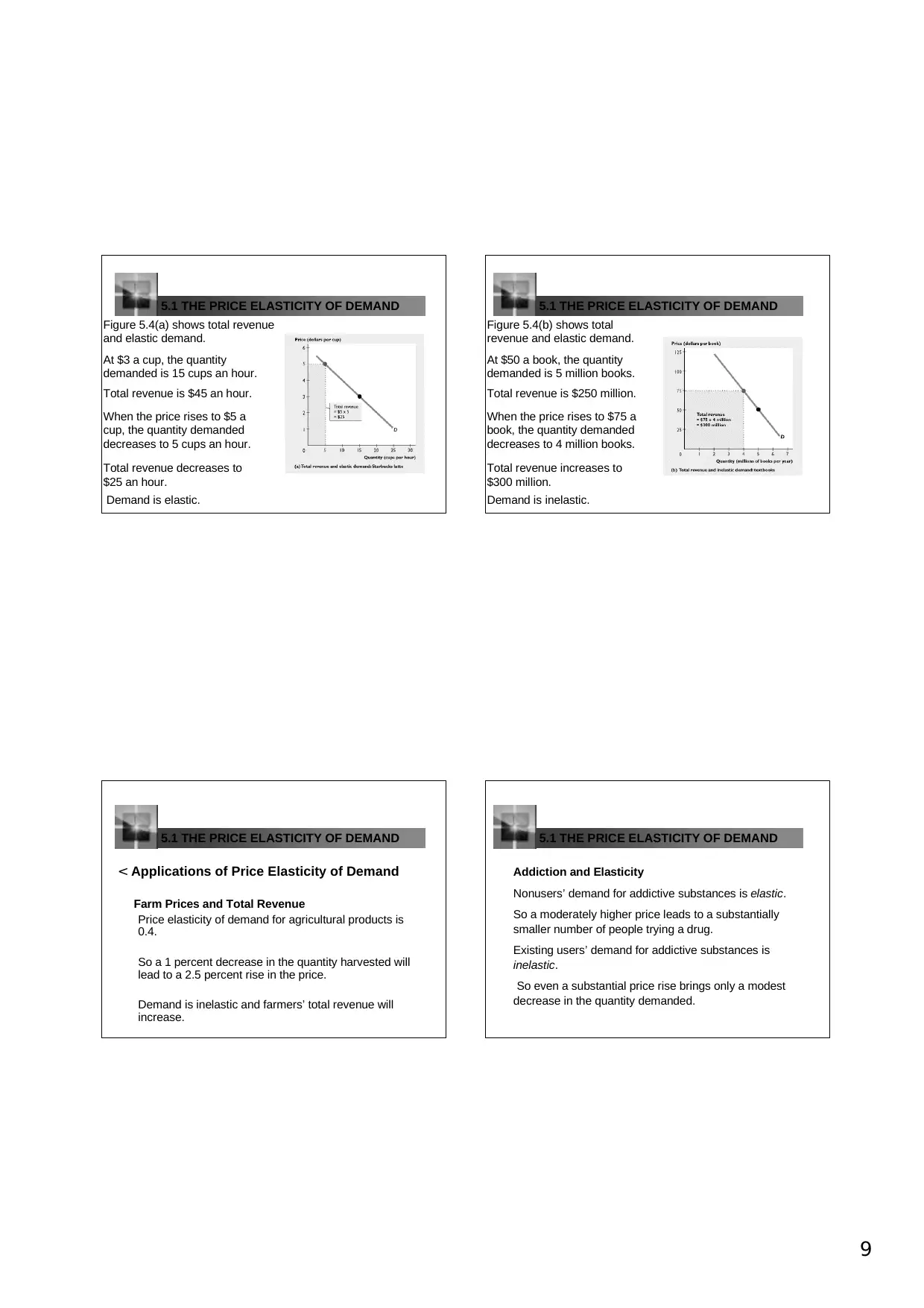
9
5.1 THE PRICE ELASTICITY OF DEMAND
Figure 5.4(a) shows total revenue
and elastic demand.
At $3 a cup, the quantity
demanded is 15 cups an hour.
Total revenue is $45 an hour.
Total revenue decreases to
$25 an hour.
When the price rises to $5 a
cup, the quantity demanded
decreases to 5 cups an hour.
Demand is elastic.
5.1 THE PRICE ELASTICITY OF DEMAND
Figure 5.4(b) shows total
revenue and elastic demand.
At $50 a book, the quantity
demanded is 5 million books.
Total revenue is $250 million.
Total revenue increases to
$300 million.
When the price rises to $75 a
book, the quantity demanded
decreases to 4 million books.
Demand is inelastic.
5.1 THE PRICE ELASTICITY OF DEMAND
< Applications of Price Elasticity of Demand
Farm Prices and Total Revenue
Price elasticity of demand for agricultural products is
0.4.
So a 1 percent decrease in the quantity harvested will
lead to a 2.5 percent rise in the price.
Demand is inelastic and farmers’ total revenue will
increase.
5.1 THE PRICE ELASTICITY OF DEMAND
Addiction and Elasticity
Nonusers’ demand for addictive substances is elastic.
So a moderately higher price leads to a substantially
smaller number of people trying a drug.
Existing users’ demand for addictive substances is
inelastic.
So even a substantial price rise brings only a modest
decrease in the quantity demanded.
5.1 THE PRICE ELASTICITY OF DEMAND
Figure 5.4(a) shows total revenue
and elastic demand.
At $3 a cup, the quantity
demanded is 15 cups an hour.
Total revenue is $45 an hour.
Total revenue decreases to
$25 an hour.
When the price rises to $5 a
cup, the quantity demanded
decreases to 5 cups an hour.
Demand is elastic.
5.1 THE PRICE ELASTICITY OF DEMAND
Figure 5.4(b) shows total
revenue and elastic demand.
At $50 a book, the quantity
demanded is 5 million books.
Total revenue is $250 million.
Total revenue increases to
$300 million.
When the price rises to $75 a
book, the quantity demanded
decreases to 4 million books.
Demand is inelastic.
5.1 THE PRICE ELASTICITY OF DEMAND
< Applications of Price Elasticity of Demand
Farm Prices and Total Revenue
Price elasticity of demand for agricultural products is
0.4.
So a 1 percent decrease in the quantity harvested will
lead to a 2.5 percent rise in the price.
Demand is inelastic and farmers’ total revenue will
increase.
5.1 THE PRICE ELASTICITY OF DEMAND
Addiction and Elasticity
Nonusers’ demand for addictive substances is elastic.
So a moderately higher price leads to a substantially
smaller number of people trying a drug.
Existing users’ demand for addictive substances is
inelastic.
So even a substantial price rise brings only a modest
decrease in the quantity demanded.
⊘ This is a preview!⊘
Do you want full access?
Subscribe today to unlock all pages.

Trusted by 1+ million students worldwide
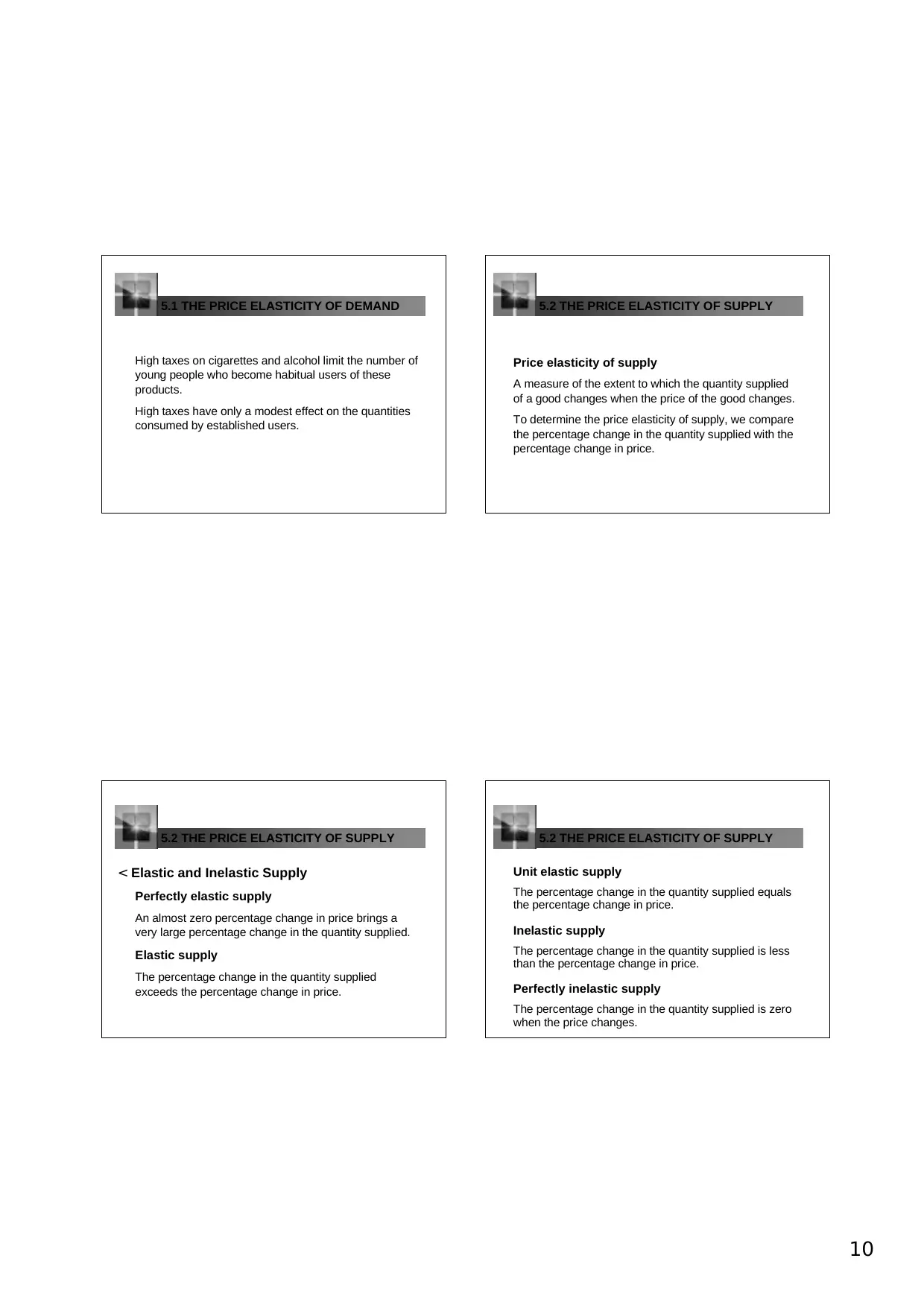
10
5.1 THE PRICE ELASTICITY OF DEMAND
High taxes on cigarettes and alcohol limit the number of
young people who become habitual users of these
products.
High taxes have only a modest effect on the quantities
consumed by established users.
5.2 THE PRICE ELASTICITY OF SUPPLY
Price elasticity of supply
A measure of the extent to which the quantity supplied
of a good changes when the price of the good changes.
To determine the price elasticity of supply, we compare
the percentage change in the quantity supplied with the
percentage change in price.
5.2 THE PRICE ELASTICITY OF SUPPLY
< Elastic and Inelastic Supply
Perfectly elastic supply
An almost zero percentage change in price brings a
very large percentage change in the quantity supplied.
Elastic supply
The percentage change in the quantity supplied
exceeds the percentage change in price.
5.2 THE PRICE ELASTICITY OF SUPPLY
Unit elastic supply
The percentage change in the quantity supplied equals
the percentage change in price.
Inelastic supply
The percentage change in the quantity supplied is less
than the percentage change in price.
Perfectly inelastic supply
The percentage change in the quantity supplied is zero
when the price changes.
5.1 THE PRICE ELASTICITY OF DEMAND
High taxes on cigarettes and alcohol limit the number of
young people who become habitual users of these
products.
High taxes have only a modest effect on the quantities
consumed by established users.
5.2 THE PRICE ELASTICITY OF SUPPLY
Price elasticity of supply
A measure of the extent to which the quantity supplied
of a good changes when the price of the good changes.
To determine the price elasticity of supply, we compare
the percentage change in the quantity supplied with the
percentage change in price.
5.2 THE PRICE ELASTICITY OF SUPPLY
< Elastic and Inelastic Supply
Perfectly elastic supply
An almost zero percentage change in price brings a
very large percentage change in the quantity supplied.
Elastic supply
The percentage change in the quantity supplied
exceeds the percentage change in price.
5.2 THE PRICE ELASTICITY OF SUPPLY
Unit elastic supply
The percentage change in the quantity supplied equals
the percentage change in price.
Inelastic supply
The percentage change in the quantity supplied is less
than the percentage change in price.
Perfectly inelastic supply
The percentage change in the quantity supplied is zero
when the price changes.
Paraphrase This Document
Need a fresh take? Get an instant paraphrase of this document with our AI Paraphraser
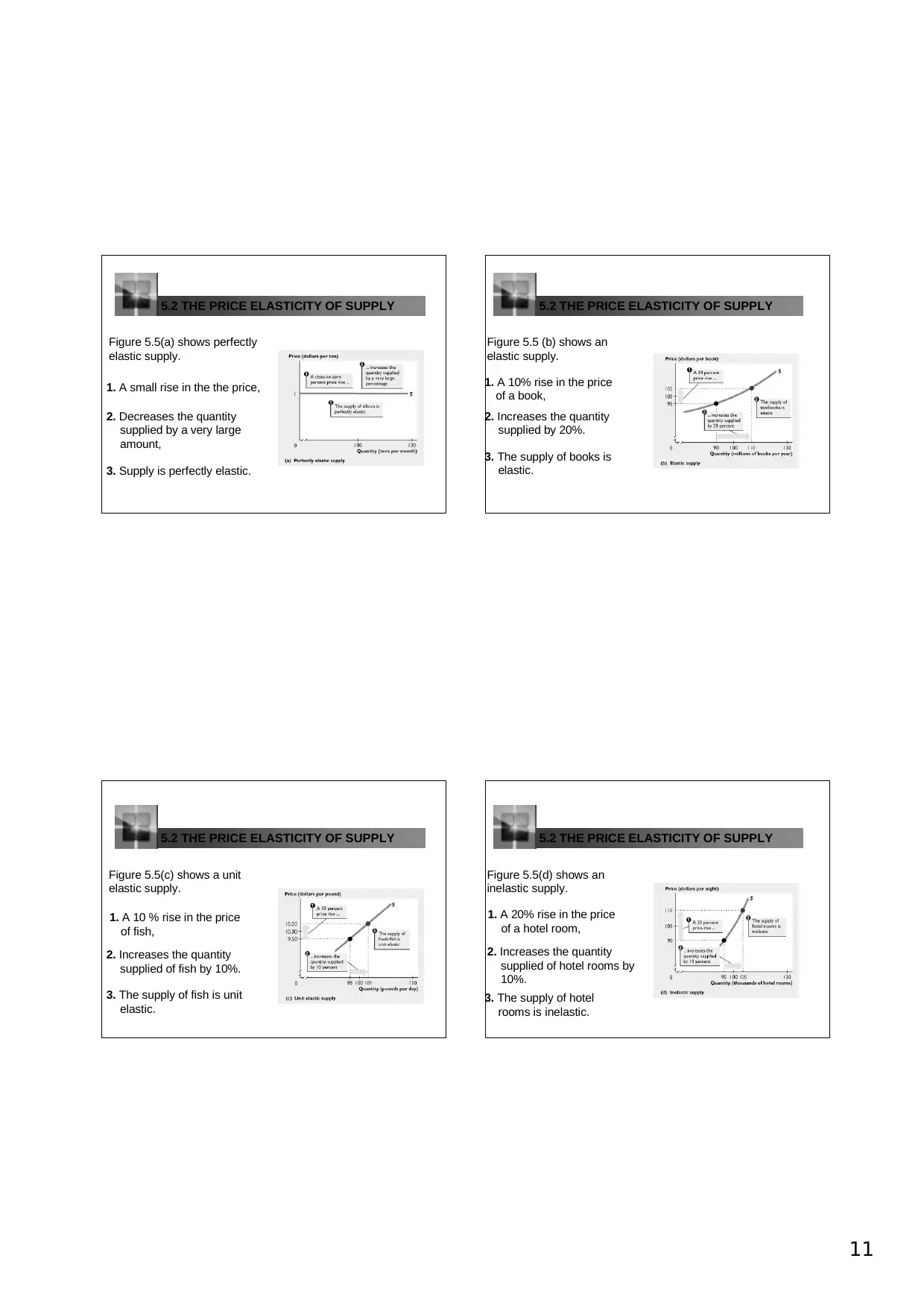
11
5.2 THE PRICE ELASTICITY OF SUPPLY
Figure 5.5(a) shows perfectly
elastic supply.
1. A small rise in the the price,
2. Decreases the quantity
supplied by a very large
amount,
3. Supply is perfectly elastic.
5.2 THE PRICE ELASTICITY OF SUPPLY
Figure 5.5 (b) shows an
elastic supply.
1. A 10% rise in the price
of a book,
2. Increases the quantity
supplied by 20%.
3. The supply of books is
elastic.
5.2 THE PRICE ELASTICITY OF SUPPLY
Figure 5.5(c) shows a unit
elastic supply.
1. A 10 % rise in the price
of fish,
2. Increases the quantity
supplied of fish by 10%.
3. The supply of fish is unit
elastic.
5.2 THE PRICE ELASTICITY OF SUPPLY
Figure 5.5(d) shows an
inelastic supply.
1. A 20% rise in the price
of a hotel room,
2. Increases the quantity
supplied of hotel rooms by
10%.
3. The supply of hotel
rooms is inelastic.
5.2 THE PRICE ELASTICITY OF SUPPLY
Figure 5.5(a) shows perfectly
elastic supply.
1. A small rise in the the price,
2. Decreases the quantity
supplied by a very large
amount,
3. Supply is perfectly elastic.
5.2 THE PRICE ELASTICITY OF SUPPLY
Figure 5.5 (b) shows an
elastic supply.
1. A 10% rise in the price
of a book,
2. Increases the quantity
supplied by 20%.
3. The supply of books is
elastic.
5.2 THE PRICE ELASTICITY OF SUPPLY
Figure 5.5(c) shows a unit
elastic supply.
1. A 10 % rise in the price
of fish,
2. Increases the quantity
supplied of fish by 10%.
3. The supply of fish is unit
elastic.
5.2 THE PRICE ELASTICITY OF SUPPLY
Figure 5.5(d) shows an
inelastic supply.
1. A 20% rise in the price
of a hotel room,
2. Increases the quantity
supplied of hotel rooms by
10%.
3. The supply of hotel
rooms is inelastic.
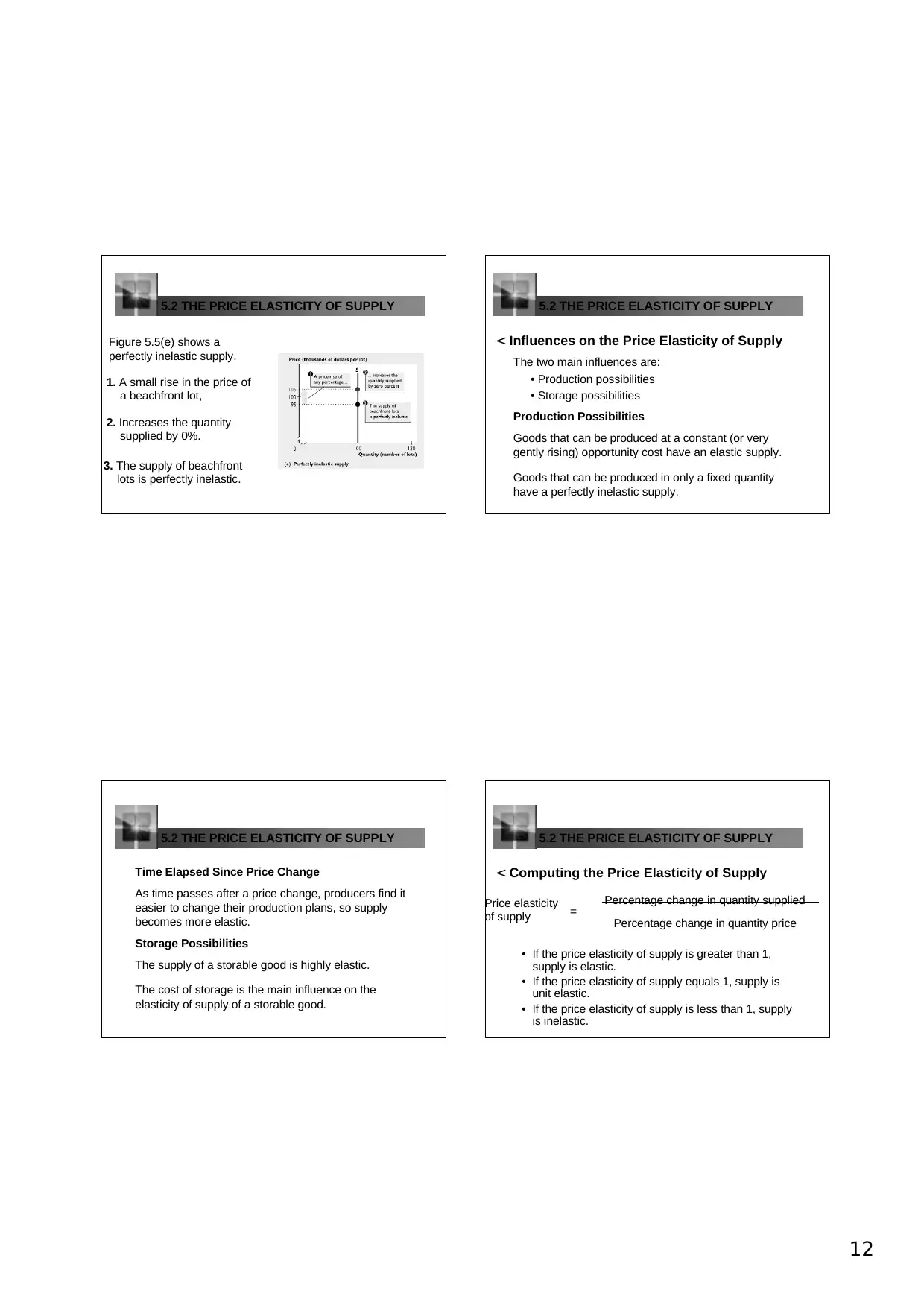
12
5.2 THE PRICE ELASTICITY OF SUPPLY
Figure 5.5(e) shows a
perfectly inelastic supply.
1. A small rise in the price of
a beachfront lot,
2. Increases the quantity
supplied by 0%.
3. The supply of beachfront
lots is perfectly inelastic.
5.2 THE PRICE ELASTICITY OF SUPPLY
< Influences on the Price Elasticity of Supply
The two main influences are:
• Production possibilities
• Storage possibilities
Production Possibilities
Goods that can be produced at a constant (or very
gently rising) opportunity cost have an elastic supply.
Goods that can be produced in only a fixed quantity
have a perfectly inelastic supply.
5.2 THE PRICE ELASTICITY OF SUPPLY
Time Elapsed Since Price Change
As time passes after a price change, producers find it
easier to change their production plans, so supply
becomes more elastic.
Storage Possibilities
The supply of a storable good is highly elastic.
The cost of storage is the main influence on the
elasticity of supply of a storable good.
5.2 THE PRICE ELASTICITY OF SUPPLY
< Computing the Price Elasticity of Supply
Price elasticity
of supply
Percentage change in quantity supplied
Percentage change in quantity price
=
• If the price elasticity of supply is greater than 1,
supply is elastic.
• If the price elasticity of supply equals 1, supply is
unit elastic.
• If the price elasticity of supply is less than 1, supply
is inelastic.
5.2 THE PRICE ELASTICITY OF SUPPLY
Figure 5.5(e) shows a
perfectly inelastic supply.
1. A small rise in the price of
a beachfront lot,
2. Increases the quantity
supplied by 0%.
3. The supply of beachfront
lots is perfectly inelastic.
5.2 THE PRICE ELASTICITY OF SUPPLY
< Influences on the Price Elasticity of Supply
The two main influences are:
• Production possibilities
• Storage possibilities
Production Possibilities
Goods that can be produced at a constant (or very
gently rising) opportunity cost have an elastic supply.
Goods that can be produced in only a fixed quantity
have a perfectly inelastic supply.
5.2 THE PRICE ELASTICITY OF SUPPLY
Time Elapsed Since Price Change
As time passes after a price change, producers find it
easier to change their production plans, so supply
becomes more elastic.
Storage Possibilities
The supply of a storable good is highly elastic.
The cost of storage is the main influence on the
elasticity of supply of a storable good.
5.2 THE PRICE ELASTICITY OF SUPPLY
< Computing the Price Elasticity of Supply
Price elasticity
of supply
Percentage change in quantity supplied
Percentage change in quantity price
=
• If the price elasticity of supply is greater than 1,
supply is elastic.
• If the price elasticity of supply equals 1, supply is
unit elastic.
• If the price elasticity of supply is less than 1, supply
is inelastic.
⊘ This is a preview!⊘
Do you want full access?
Subscribe today to unlock all pages.

Trusted by 1+ million students worldwide
1 out of 15
Related Documents
Your All-in-One AI-Powered Toolkit for Academic Success.
+13062052269
info@desklib.com
Available 24*7 on WhatsApp / Email
![[object Object]](/_next/static/media/star-bottom.7253800d.svg)
Unlock your academic potential
Copyright © 2020–2025 A2Z Services. All Rights Reserved. Developed and managed by ZUCOL.




